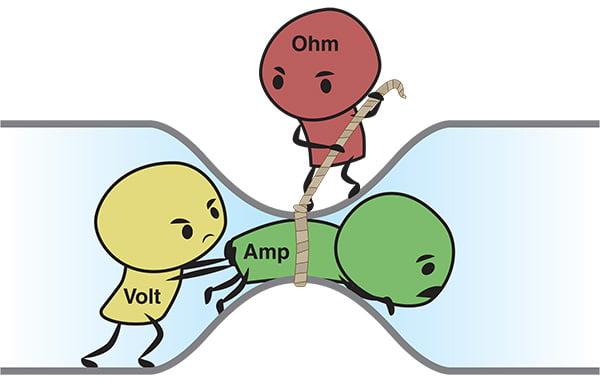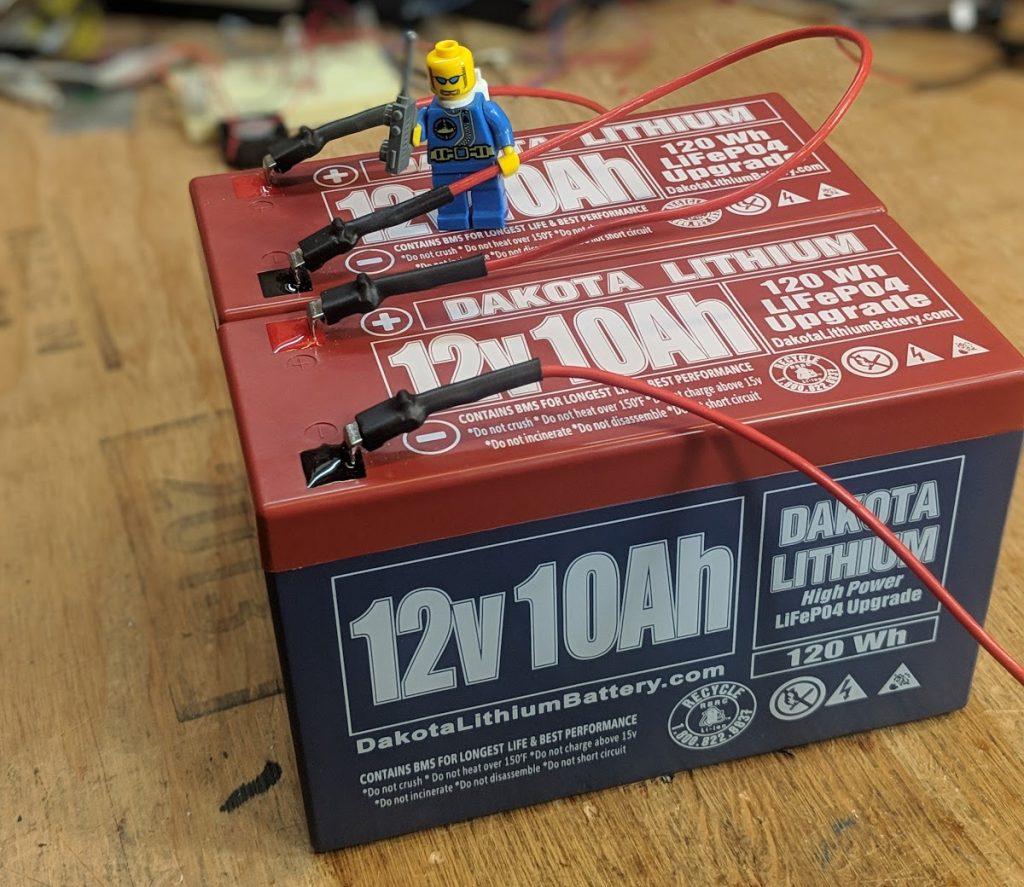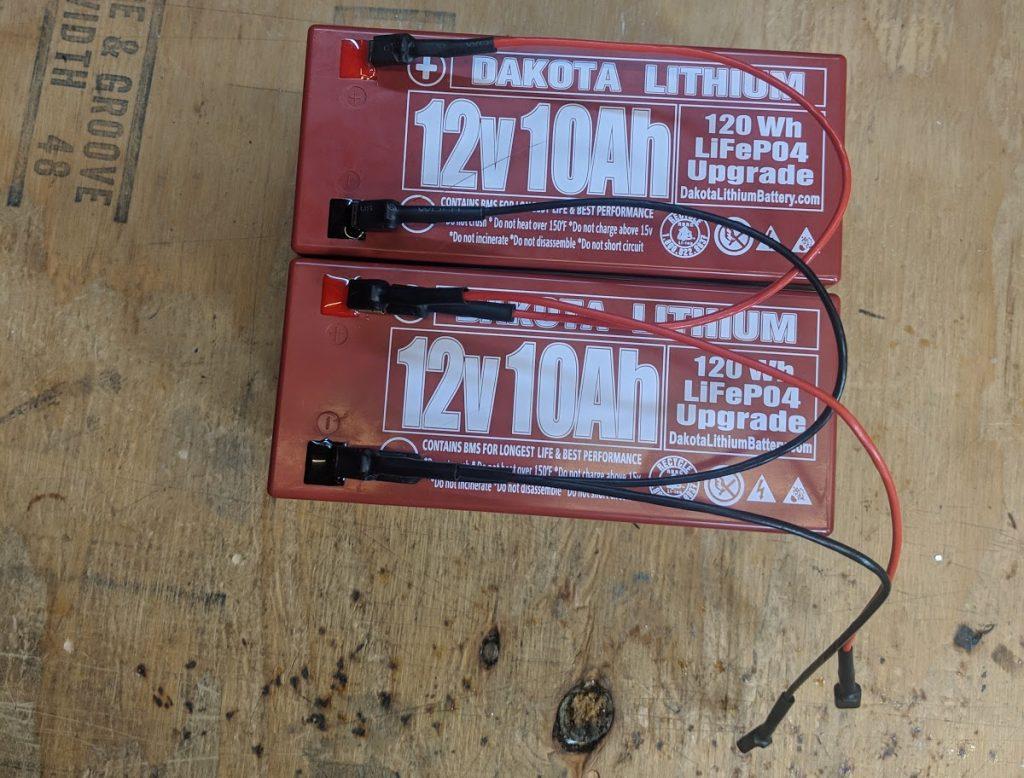Here at Dakota Lithium we pride ourselves on the domestic manufacturing of robust and reliable LiFePO4 batteries. It probably comes as no surprise that we get a lot of battery-related questions.
One of the most common queries is “I need more power! Do you have a battery that can give me more volts or more amps?” The answer is yes. All of our batteries can be connected to produce more power to run bigger motors (voltage – v), or extra capacity (amp hours – Ah). This called wiring a battery in series or in parallel.
Wiring a battery in series is a way to increase the voltage of a battery. For example if you connect two of our 12 Volt, 10 Ah batteries in series you will create one battery that has 24 Volts and 10 Amp-hours. Since many electric motors in kayaks, bicycles, and scooters run on 24 volts this is a common way of wiring batteries. For example, a number of the pro-bass fisherman that Dakota Lithium sponsors use 36 Volt electric trolling motors (so they can quietly sneak up on fish). They wire 3 of our 170 Ah batteries in series to give them over 17 hours of trolling motor time. That’s enough juice for a week long fishing tournament!
Wiring a battery in parallel is a way to increase the amp hours of a battery (i.e. how long the battery will run on a single charge). For example if you connect two of our 12 V, 10 Ah batteries in parallel you will create one battery that has 12 Volts and 20 Amp-hours. Since many small electric motors, solar panels, RVs, boats, and and most household electronics run on 12 volts this is a common way of creating a battery that will last a super long time. For example, a sailboat captain who does long open water expeditions and needs a long lasting power system wired 80 of our 12 V, 10 Ah batteries in parallel to create an 800 Amp-hour battery. This allows him to run all of his sail boat electronics for up to a month between charges. That’s enough time to sail from San Francisco to Hawaii on a single charge!
“Wait…” some of you might be saying here. “‘Connecting batteries?’ ‘Series or parallel?’ What black magic is this?!”
Well, let’s dig a little deeper into understanding the physics behind the magic.
For the purposes of this post, we’ll be talking about two different battery metrics: voltage (V) and ampere-hours or amp hours (Ah).
If you think of electricity as water flowing through a system of pipes, voltage is best thought of as water pressure and so is the metric by which we can measure how forcefully electrical current flows. Amps would be the size of the pipe that that water flows through, and thus is the metric by which we measure how much power we can output at a given moment. Amp hours then, in this instance of plumbing analogies, is a measure of how many gallons of water are moving through your pipes over time.

I’ve always found this image (and many like it on the internet) to be helpful in explaining electricity.
So, what happens if we connect batteries in series? The newly combine unit’s voltage rating increases. For example, if connecting two of our 12V 10Ah Dakota Lithium batteries in series, what you’ll get is a doubling of voltage or a 24V 10Ah battery pack.
What about connecting a pair of batteries in parallel? The newly combined unit’s ampere-hours rating increases. Using the same two 12V 10Ah Dakota Lithium batteries, what you’ll end up with is a doubling of ampere-hours, or a 12V 20Ah battery pack.
In both cases, adding more Dakota Lithium batteries in series or parallel will simply add on an additional 12V or 10Ah, respectively.
Pretty simple, right? Totally not black magic!
All that being said, it behooves us to mention here that there are 3 considerations that need to be taken into account before wiring batteries up in series or parallel:
So, now that we’ve confirmed that you can indeed connect our batteries in series or parallel, how does one go about doing so? Well, you’re going to need some wires (rated for your specific amperage requirements; we use 14-gauge stranded wires in our ebike kits) with F2 female spade connectors and two (or more) fully charged batteries. The batteries should be fully charged so that the cells are more or less balanced such that it maximizes your overall use time. After all, your parallel or series-wired batteries are only as good as their weakest link and will operate only as long as the least charged cell.

To wire batteries in a series, you will first need to connect the positive ( + ) terminal from Battery A to the ground or “negative” ( – ) terminal of Battery B.
Next, you will need to connect the open positive and negative terminals on Battery A and B to your specific application (e.g. a motor, lights, etc.).

And there you have it! You have a battery connected in series!

As the name implies, parallel connections are pretty straightforward. To start, you will want to connect the batteries’ positive ( + ) terminals to one another.
Next, you’ll want to connect the ground or “negative” ( – ) terminals to one another.

And lo! Now you have a battery connected in parallel! You should be able to connect your application to one of the batteries and get all the batteries in parallel to discharge equally, however it is preferred to have your application connected to the positive terminal of one battery and the negative terminal of another. This should help your batteries stay balanced over the long term.
Now that you are a master of magic the possibilities are endless….
You might have a set of batteries wired up in series and parallel now, and if so, great! However, you can also further combine your parallel and series-wired batteries together, again, in either series or parallel. Again using the example of our Dakota Lithium batteries, you could take four batteries to create a large, four-module battery pack that is either 24V 40Ah or 48V 10Ah!
Resources
https://batteryuniversity.com/learn/article/serial_and_parallel_battery_configurations
https://www.batterystuff.com/kb/articles/battery-articles/battery-bank-tutorial.html
Notes: